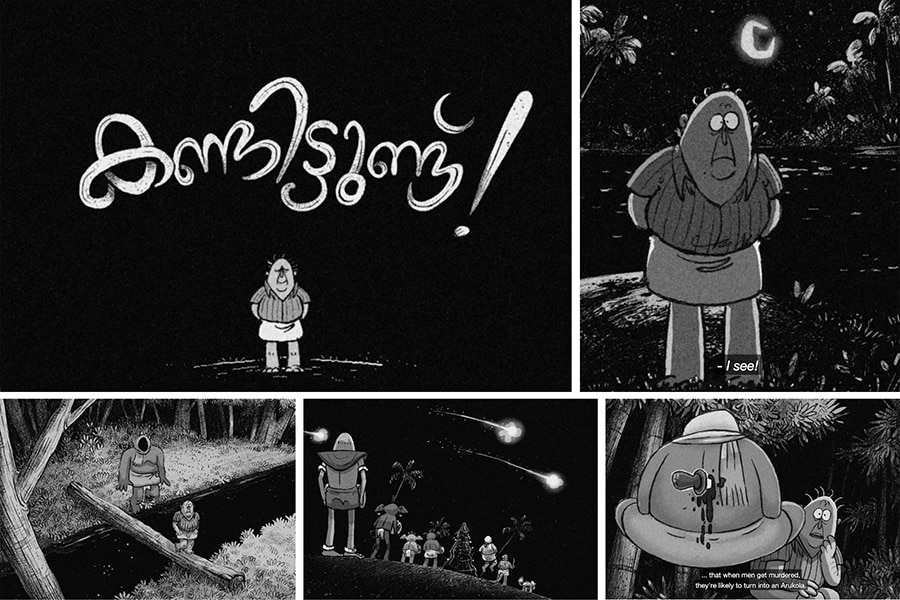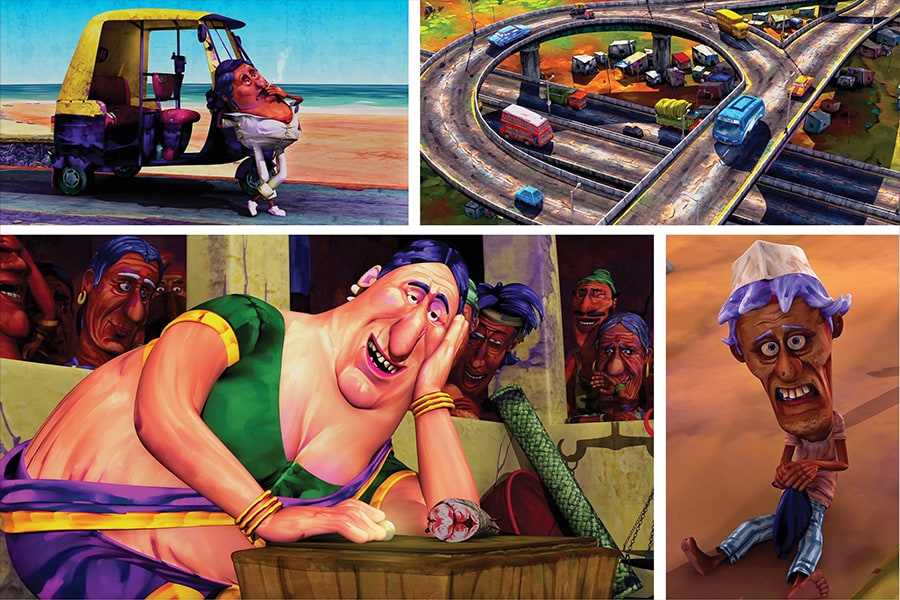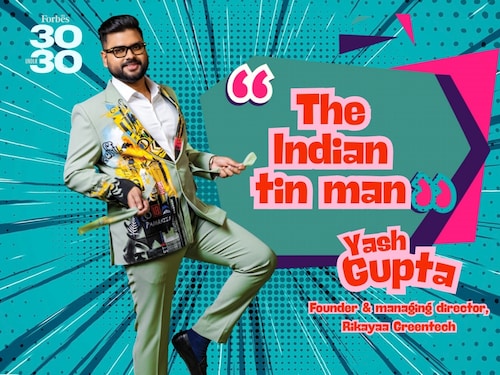“Also, I believe that such stories and tellers exist in every nook and corner of the country, it will be a treasure to archive them if we can retell their stories in a brand-new form."
Since the subject was too close and personal to Eriyat, it required a neutral perspective. Krishnadas, 25, heard of the opportunity at Studio Eeksaurus and started work on the project Kandittund! in 2019, which was entirely financed by the studio.
Adithi Krishnadas: The stories have an underlying humour to them, which mostly comes from the fact that Mr Panicker narrates the ghost stories as if he has actually encountered them, but on closer questioning, he corrects himself and fumbles the story details quite a lot. So the visualisations of the situations and the way the ghosts are drawn have that skepticism and humour running through them. The style of the film was chosen to be black and white, mostly because of the nocturnal nature of the stories and their supernatural edge. And also for the simple reason that it looked attractive.
Q. Tell us about the process of characterisation? How did you arrive at the look of the ‘ghosts’?
AK: The characterisation of the ghosts was sometimes based on the features mentioned in the narration, like the ghost Thendan having huge eyes, but mostly it was just what appeared funny at first glance or was derived from shapes that felt nice to draw over and over again. Since the film leans more towards humour than horror, the characters also appear as such.
![]() Kandittund! bagged the Best Animation Film Award at the 69th National Film Awards 2023 Image: Courtesy Studio Eeksaurus
Kandittund! bagged the Best Animation Film Award at the 69th National Film Awards 2023 Image: Courtesy Studio Eeksaurus
Q. Sound plays a very important role in the film. Tell us about your collaboration with academy award winning sound designer Resul Pookutty.
SE: Absolutely true. Sometimes in animation films, I feel sound plays more than 50 percent of the role in comparison with the visuals. Music was another very important creative space in this film. We had to find authentic folk drums and other instruments to make the animated world feel complete. Nandhu Kartha is a very talented music director, and we signed him up to work on the music. I give huge importance to getting the sound right for our films. Here too, it must have taken more than 2–3 months to finally arrive at this soundtrack.
Resul is a dear friend, apart from being a hyper-talented sound superman! But to define this space, we had to go a bit back and forth. One big obstacle was that the sound design team was not too familiar with animation film sound design, where weightless line drawings gathered weight through sound. Also, we were sending a rough black and white line-up of the film, from which they couldn’t tell whether it was day or night.
Resul, being the big R of our Bollywood industry, has been working on huge canvas films for a while, and his sensibilities are quite accustomed to such elaborate, high-scale, and heavily detailed sound design work. But we wanted to bring the nostalgia of old times back into this film—the times when sounds were subtler, noise was negligible, and musicality was omnipresent in nature, and we could hear them too in a noiseless background. It was a space where small would mean and feel big in our context. I shared some Malayalam films from the late 70s with Resul and instantly Resul understood the space, and then there was no looking back. He and Vijay reworked the entire soundscape, and we got what we have now, which is world-class. I am hugely indebted to his patience and support.
Q. Talk us through your journey into the world of animation.
SE: I was always interested in all sorts of arts and crafts. My design education was the key that opened doors to this wonderful world of creativity that I am so happy to be in. I grew up in Kerala till the age of 17, and I got lucky to be one of the 30 who got selected for a 5-year MDes program at the mecca of design (NID!). At the very onset of NID, I was christened "Eeks!’ by loving seniors! Eeksaurus, the name of our studio, came from there, thanks to those creative minds.
I will be 50 at the end of this year, but I still feel as young as those days in NID when I was in my twenties. But the 50 extra kilos that I put on through the last 25 years in the Mumbai media industry add an extra bit of gravity, not allowing me to fly.
When I left my partnership with Famous Studios in 2009, 11 years after founding and running Famous House of Animation with over 200 films to my name, I was unsure of how I should go about my next move. But I remember Nilima, my partner, telling me to keep the name Eeksaurus and start doing all that I wished to do creative under that banner. I told her no one will be able to pronounce Eeksaurus right, and she said that when our work speaks for itself, people will learn to pronounce our name right! We decided we would expand our canvas with our Eeksaurus venture, and that’s exactly what happened. I wanted to direct live-action stylised films along with animation films. We actually managed to do it and found a niche over there through Eeksaurus. Thanks to her guts and backing, we just did exactly what we wanted, the way we wanted it all these years. Nilima is our executive producer on our films, and being a graphic designer and animator first, her sense of the creative business side is very progressive and innovative.
My choice of animation was mainly triggered by the strength and freedom one would have to make a film or an audio-visual essay from a figment of imagination, an idea, or an experience that we may call a story when manifested—basically, to make a film out of literally anything and, most importantly, all by yourself. This was the main excitement behind the choice of animation. Do I physically sit and animate now? No! Would I like to? Yes! But I feel that working with animators and people with similar aspirations has helped me create the body of work that I have today, along with spreading the importance of animated storytelling through them. Having more than 500 films with my name attached to them is something I never dreamed of! I am absolutely grateful for being part of such a large body of work! With over 200 awards and an almost similar number of official selections at various festivals around the globe, if I say our work is better recognised outside than within India, it wouldn’t be wrong.
Q. Awards and recognition that mean the most to you and Team Eeksaurus…
SE: The ANNECY Cristal for Best Animated Film in the Commissioned Films Category, the only one for India, still holds supreme value to us. A Cristal from ANNECY is as big as an Oscar for animation. This took place in 2015 for our Fateline film for Rotary. Till date, no other Indian contingent has yet won another Cristal, even though I wish we should bring more of them home. I am way too grateful for the three national awards for Best Animation Film (in 2015 for Fisherwomanand Tuk Tuk, in 2017 for Tokri and in 2023 for Kandittund!). Our films have also won at Cannes Lions, Clio, D&AD, Asia Pacific Adfest, Digicon Japan, and many other prestigious film festivals around the globe. These awards, to me, become stamps of approval and appreciation for the sincere efforts that Team Eeksaurus has been putting forth behind each of our films. We strive to make each and every film a change-maker in the perception of Indian animation within our country and abroad.
Something I value a lot is the invitation we received from the Ghibli Museum to present our film Tokri there. That was like a dream come true moment for us. They even took the essence of our film Family Bonds as the theme of their animation film festival that year!
Q. What was special about your other award-winning projects Fisherwoman and Tuk Tuk and Tokri.
SE: Fisherwoman and Tuk Tuk (FWTT) and Tokri were both in-house, self-funded initiatives. I came up with these stories inspired by certain events that I experienced in and around Mumbai. The intent and the vision was to bring local stories to the Indian masses with a display of superlative craft using complex, never-before-seen animation techniques. This was also intended to make our young and scattered team members work as a unit and learn from the process to get prepared to go for the long format. The warm reception we received for both films on YouTube—over 38 million views for FWTT and 10 million views for Tokri—is really the best award that came totally unexpectedly, since both the films were not ‘funny’ cartoons—a label an animation film gets stamped with by default in India—just because people are not exposed to other forms of animated storytelling. I am sure we will change that perception slowly but steadily.
![]() Stills from the film Fisherwoman and Tuk Tuk, winner of the Non-Feature Animation Film Award at the National Film Awards 2016 Image: Courtesy Studio Eeksaurus
Stills from the film Fisherwoman and Tuk Tuk, winner of the Non-Feature Animation Film Award at the National Film Awards 2016 Image: Courtesy Studio Eeksaurus
Q. Is there an underlying philosophy that you follow in the projects that you take on?
SE: Our intent with Studio Eeksaurus was and is to tell stories medium-agnostically. Like I mentioned above, I love all art and craft forms and using the design process to come up with the best route to fit the story. I would like to connect with and work with as many mediums of art as possible in this lifetime. I feel the only worthwhile contribution the human race has made towards Mother Nature is art! Otherwise, all other in(ter)ventions of ours have a direct or indirect detrimental impact on nature. So, be it live action, animation, print, sculptures, textiles, or any expression of art, it can become a canvas for us to tell stories.
Animation is very close to our hearts, and my vision is to popularise animated storytelling, especially to bring out the local stories in the most visually crafted ways. Today we are mentoring, funding, and producing films by young animation film makers who can further spread our vision and create an OTAKU (mad fan) following for Indian animation like the Japanese anime followers from around the world. This is the only way we can boost Indian animation the way we are proud of it.
We need to groom, graft, and nourish young artists and animators to find meaning in the making of films, even if a lifetime may go into that struggle.
My vision takes the reference from the Japan phenomenon. The Japanese created Anime for local consumption. Their animation didn’t have as many drawings as Disney animation, nor did they go for the smoothness that Disney popularised with their animation. The idea was also to make it cost-effective for local use. What transpired became a loved trend among the masses in Japan very fast and it soon became even bigger than their live-action film industry (a very aspirational industry with many celebrated directors). If we can recreate the same effect with our local animated content, which is also ‘good’ in terms of quality of storytelling, then we will definitely find acceptance from the Indian masses. Then the biggest and most awaited national award would be for the best animated feature, series, or short film, along with an award for the best animated character, and not for the big Bollywood blockbuster! That’ll be the day!
Q. The process of animation is so painstaking and time consuming—a labour of love—yet it gets little attention when the national awards are announced. Feature films hog all the attention. Do you think animation is getting its due?
SE: Animation is not getting its due because it is not yet making a difference at a national level. Like I mentioned above, if we can make our local stories accepted by our locals, then we have a very bright future! Currently, we are in an ‘ape’ mode. Replicating what was successful in the West.
Secondly, animation in India is more associated with animation as a skill than animation filmmaking yet. Ninety-five percent of Indian animation would cater to the needs of international series/cinema or games in terms of all tech and skill-based support, including animation. This mode of business is the biggest priority for most animation studios in the country. That makes us the rarest of the rare animation species! VFX, which are mainly visual embellishment for live action features, are better recognised than animation in our country! That’s the irony. And even people in Bollywood confuse between VFX and animation. They feel both are the same or similar. With VFX, you can’t tell a story, while animation is a medium to tell stories!
Q. Can you highlight the issues that plague the animation industry? What are the challenges you have faced.
SE: The issue that plagues the country in the area of animation is sheer ignorance at multiple levels. Sometimes animation is perceived as a skill, it is mistaken as a software skill too! If you know how to operate a particular XYZ software, then you are termed as animator. We call ourselves animation filmmakers to distinguish us from them. People who run animation studios in India know that the value of animation abroad is 20 times higher than what we get in India, and hence they take on those projects at cheaper prices making the international players earn huge margins by outsourcing them to India and we make a killing in India still with the money they’d pay, which would still be way higher than what Indian companies would pay for animation or wages. Especially in advertisements, 2 million USD is a normal budget in the US for a 1-minute-long ad film and they would get 6-9 months to make them too. Because the companies are aware that such films take time and will work in their favour once they are built right, however painstakingly expensive and time consuming they may be. In India, the films are needed ‘yesterday’, and for money, peanuts is offered in comparison with live action films, which, according to me, are far simpler to make when compared with an elaborate animation film.
Q. With the advent of AI and other technological advancements, where does hand drawn animation/clay animation stand? How is the studio planning to embrace the change?
SE: I think hand drawn/handmade animations are irreplaceable unless people themselves give up doing/practising them because of the ease/comfort that tech and AI would bring to them. We look at the young to upgrade us rather than the old to take us forward. We have always been a very young company in terms of average age group. They are savvy and their aspirations along with ours, once aligned we never feel challenged with the advent of different tech upgrades. Mostly the tech/AI is here to enable us with a better toolset and not to replace humans. Like any tech wave did in the past, no doubt this too will displace jobs and cause redundancies.
Q. Your advice to aspiring animators…
SE: It is still the perseverance and staying close to the ground while gathering speed at the onset that enables you with a better take off/flight. There’s no ‘instant’ success formula, especially with animation.




